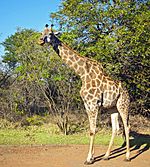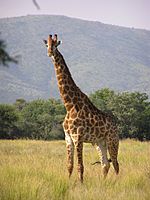Southern giraffe facts for kids
The southern giraffe (Giraffa giraffa) is a type of giraffe that lives in Southern Africa. Some scientists think it should be its own species. However, the IUCN, a big group that studies animals, currently says there is only one species of giraffe with nine different kinds (called subspecies).
Southern giraffes have round or blotchy spots. Some spots have star-like shapes on a light tan background. These spots go all the way down to their hooves. They live in countries like South Africa, Angola, Namibia, Botswana, Zambia, Zimbabwe, and Mozambique. There are about 44,500 southern giraffes in the wild.
All giraffes are currently considered Vulnerable to extinction by the IUCN. This means they could be in danger if we don't protect them.
Contents
How Scientists Classify Giraffes
Scientists group living things to understand them better. In 1758, a scientist named Carl Linnaeus first classified all giraffes as one species. Later, in 1772, the group Giraffa was created for giraffes.
For a long time, all giraffes were thought to be one species called Giraffa camelopardalis. But recent studies have suggested that the southern giraffe might be a separate species, called Giraffa giraffa. This idea is still being discussed by scientists. The IUCN still recognizes only one giraffe species with nine different subspecies.
Southern Giraffe Subspecies
Scientists have suggested two main types, or subspecies, of the southern giraffe.
| Subspecies | What They Look Like and Where They Live | Image |
|---|---|---|
| Angolan giraffe (G. g. angolensis), also known as Namibian giraffe | This giraffe lives in northern Namibia, parts of Zambia, Botswana, and western Zimbabwe. A study in 2009 suggested that giraffes in the northern Namib Desert and Etosha National Park might even be separate subspecies themselves! This type of giraffe has large brown blotches. The edges of these blotches can be a bit jagged or have pointy parts. The spots go down their legs but not much on their upper face. The spots on their neck and rump are usually quite small. They also have a white patch on their ears. About 13,000 Angolan giraffes are thought to be in the wild, and about 20 live in zoos. |  |
| South African giraffe (G. g. giraffa), also known as Cape giraffe | You can find this giraffe in northern South Africa, southern Botswana, southern Zimbabwe, and south-western Mozambique. It has dark, somewhat rounded spots. These spots have "fine projections" on a brownish-yellow background. The spots continue down their legs and get smaller there. Male South African giraffes have a less developed bump on their head compared to some other giraffes. Around 31,500 South African giraffes are believed to be in the wild, and about 45 live in zoos. |  |
Appearance
The Cape subspecies of the southern giraffe has dark, somewhat rounded spots. These spots have small, thin extensions on a brownish-yellow background. The spots go down their legs and become smaller as they reach the hooves. Male giraffes of this type have a less noticeable bump on their forehead.
Where They Live and Their Home
Southern giraffes live in the open grasslands (savannahs) and woodlands of northern South Africa, Angola, southern Botswana, southern Zimbabwe, Zambia, and south-western Mozambique. In some areas where they had disappeared, South African giraffes have been brought back. This includes places like Swaziland. They are commonly found both inside and outside protected areas.
What They Eat and How They Live
Southern giraffes usually live in savannahs and woodlands. These places have plenty of plants for them to eat. Southern giraffes are plant-eating mammals. They mostly eat leaves, flowers, fruits, and new shoots from woody plants, especially from trees like Acacia.
Threats to Southern Giraffes
Good news! Southern giraffes are not currently considered threatened. In fact, their population is actually growing!

